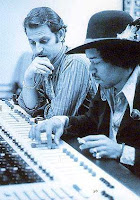 Back on the Tube, I found myself in St. John’s Wood, an upscale London neighborhood that houses EMI’s Abbey Road Studios. The place made famous by The Beatles, Pink Floyd and many more. Crossing the magical zebra crosswalk that The Beatles used for the cover photo of their album Abbey Road
Back on the Tube, I found myself in St. John’s Wood, an upscale London neighborhood that houses EMI’s Abbey Road Studios. The place made famous by The Beatles, Pink Floyd and many more. Crossing the magical zebra crosswalk that The Beatles used for the cover photo of their album Abbey Road It was easy to envision a very nervous, yet determined Jimmie Nicol striding up the stairs, with his friend John Hodkinson in tow, moving through the throngs of newsmen into Studio 2 for his rehearsal/tryout with The Beatles. A 20 minute session that would change his life forever. At the end of the audition, John Lennon said to Nicol, "You're in." What happened before and after that momentous occasion will be revealed in detail with the release of The Beatle Who Vanished, coming soon.
It was easy to envision a very nervous, yet determined Jimmie Nicol striding up the stairs, with his friend John Hodkinson in tow, moving through the throngs of newsmen into Studio 2 for his rehearsal/tryout with The Beatles. A 20 minute session that would change his life forever. At the end of the audition, John Lennon said to Nicol, "You're in." What happened before and after that momentous occasion will be revealed in detail with the release of The Beatle Who Vanished, coming soon.A few years later, this studio was the place where Brian Epstein brought his protégé Tommy Quickly to record “You Might As Well Forget Him”. One of many recording dates Jimmie Nicol would play in the first half of 1964 before becoming a deputy Beatle. Today, the building looks every bit the same as it did in the 1960s, with one exception. Rock and Roll has died at this site only to be replaced by Opera! The studio is long gone, but today the building serves as the location housing the English National Opera. Give me the Kinks any day! Oh well, I guess that is what they call progress.
 |
| Decca Studio today |
Next stop, the former Pye Studios. Pye was the place where, among other things, Nicol recorded his own Jimmie Nicol & the Shubdubs singles and his famous Ska records with Cyril Stapleton and Chris Farlowe under the fictitious band name The Beazers. Their night club hit song was called The Blue Beat. Take a listen back to swinging 1964.
Walking through London’s famous Marble Arch to get there, I was not surprised to find Pye studios gone.
This is valuable upscale real estate located in the heart of London tourism. Pye has now been turned into a huge, upscale Gentlemen’s Casino that takes up the entire block on Bryanston Street.
 |
| Pye Studios building today |
 |
| Eddie Kramer and Jimi Hendrix at Pye 1960s |
Next time, the Rock And Roll Detective meets and has lunch with a Beatle in Kensington! Is it The Beatle Who Vanished? Stay tuned.
2011 (C) Rock And Roll Detective(r), LLC.
To sign up for book release information on The Beatle Who Vanished, email:
jimberk@yahoo.com









